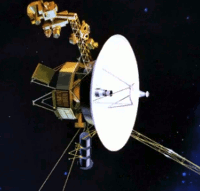
Common Core State Standard
SL.CCS.1/2/3/4 Grades 6-12: An essay of a current news event is provided for discussion to encourage participation, but also inspire the use of evidence to support logical claims using the main ideas of the article. Students must analyze background information provided about a current event within the news, draw out the main ideas and key details, and review different opinions on the issue. Then, students should present their own claims using facts and analysis for support. FOR THE WEEK OF SEP. 23, 2013 Voyager, a U.S. spacecraft on an epic journey, is first to leave our solar systemFind another report about science or engineering and summarize what's new and interesting.
Using that same story, or any other involving technology, list what skills are needed by workers in the main field covered.
Look for other positive news from a government agency or program. Tell who benefits now or in the future.
Major achievements can take a long time – such as 36 years in the case of one that America's space agency announced this month. Voyager 1, a craft launched in 1977, made history by becoming the first human-made object to leave our solar system. This long-flying spaceship is now 12 billion miles from Earth, beyond the sun's atmosphere. The distance is so vast that it takes 17 hours now for its radio signals to reach NASA receivers. The original goal was to survey the planets Jupiter, Saturn, Uranus and Neptune -- a task it and a craft called Voyager 2 completed in 1989. They were then steered toward deep space. Their radioactive plutonium power sources are expected to stop supplying electricity in about 10 years, at which point their instruments and transmitters will die – though the hardy probes will continue to float silently through interstellar space. Years ago, Voyager 1 sent back some of the earliest close-ups of Jupiter and Saturn, as well as a distant photo of Earth as a pale blue dot in space. The discovery of active volcanoes on Jupiter’s moon Io, of the intricate nature of Saturn’s beautiful rings and of many more moons than were previously known around each of the four outer planets are examples of the project's many additions to knowledge about our solar system.
Front Page Talking Points is written by
Alan Stamm for NIEonline.com, Copyright 2024
Front Page Talking Points Archive►Election drama: Democratic convention will pick a nominee as Biden ends campaign against Trump ►President Biden, 81, resists calls to let a younger Democrat run against Donald Trump ►Turning point: Supreme Court says presidents have 'absolute immunity' for official acts ►First Biden-Trump debate of 2024 airs Thursday from Georgia ►Health experts monitor the jump of bird flu to cows and a few farm hands, but see no wide risk ►Negro Leagues stars from a bygone era gain new standing in Major League Baseball records ►Justice Samuel Alito adds two flags to Supreme Court ethics storms ►Use of new weight-loss drugs soars among teens ►Needy families await action on bill to restore federal internet service rebates |

